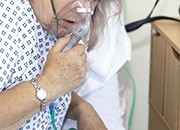Permanent Nerve Damage for Some COVID-19 Survivors
By Alan MozesHealthDay Reporter

FRIDAY, Sept. 4, 2020 (HealthDay News) -- Placing a hospitalized COVID-19 patient in a face down position to ease breathing -- or "proning" -- has steadily gained traction as a pandemic lifesaver. But a small new study warns that it may lead to permanent nerve damage.
The concern is based on the experience of 83 COVID-19 patients who were placed face down while attached to a ventilator. Once they improved, all began post-COVID-19 rehabilitation at a single health care facility.
By that point, roughly 14% had developed a "peripheral nerve injury" (PNI) involving one or more major joints, such as the wrist, hand, foot or shoulder.
Despite that damage, study author Dr. Colin Franz said proning "is a lifesaving intervention, and we think it is saving lives during the COVID pandemic."
And although placing patients face down has been known to cause skin pressure injuries in non-COVID-19 patients, he said nerve compression injuries are typically uncommon with regular repositioning and careful padding.
"So we were very surprised to find 12 out of 83 patients with nerve injuries," said Franz, neurology director of the Regenerative Neurorehabilitation Laboratory at Northwestern University Feinberg School of Medicine, in Chicago.
He characterized the nature of the nerve damage as so severe that affected patients were "unlikely to fully recover."
The damage included loss of hand function, frozen shoulder and foot dragging that may lead to a need for a brace, cane or wheelchair.
"Full recovery for nerve damage is estimated to occur in only about 10% of patients under the best of circumstances," Franz explained. "And the recovery that does take place will happen over 12 to 24 months."
In other words, the nerve damage might be the longest-lasting effect of COVID-19 for most of these patients, he suggested. And if the risk seen among the study group is any indication, thousands of patients worldwide could have the same damage, Franz said.
Franz noted that some, but not all, of the patients had pre-existing conditions such as diabetes that made them more likely to have nerve injuries from compression. Many of the patients were also old or obese.
But he and his colleagues suspect something about COVID-19 infection itself makes nerves more vulnerable to damage. Among the possible triggers: the increased inflammatory state brought on by SARS-CoV-2, the virus that causes COVID-19, as well as poor blood circulation and blood clotting.
Prone-triggered PNI may also result from "the way patients are positioned and the weight it may put on certain nerves for prolonged periods of time," said Dr. Armeen Poor, an attending physician of pulmonary critical care medicine at Metropolitan Hospital Center in New York City, who reviewed the findings.
Another possible contributor: overworked hospital staff.
During the height of the pandemic, said Poor, "many hospitals were proning more patients at a time than usual. This excess strain on staff could have compromised the frequency of careful patient repositioning while prone, and potentially increased the risk of nerve injury."
Dr. Nicholas Caputo, an associate chief and attending emergency physician at Lincoln Medical and Mental Health Center, Bronx, N.Y., also reviewed the findings. He said it's important to recognize that this study focused only on patients proned while on a ventilator.
But, he noted, proning has been successfully deployed among non-ventilated patients, often in hopes of staving off ventilation. Such "self-proning" patients are awake and "instructed to change positions if they become uncomfortable."
In the intensive care unit, however, ventilated patients are generally proned for eight to 12 hours before being turned, Caputo said. "This puts much more pressure on certain areas of the body, and places the patients at risk for complications such as peripheral neuropathies," he added.
Hoping to reduce prone-linked PNI risk among intubated patients, Franz's team has been "mapping" regions most vulnerable to nerve damage. That information could help doctors, nurses and physical therapists deploy modified positioning, extra padding and protection of vulnerable areas. Wearable sensors could be used to "measure and monitor [the] loading of nerves," he said.
"In medicine we focus on 'ABCs' -- airway, breathing and circulation -- when there is an emergency," Franz said. "Intubation and proning positioning fall within these categories and save lives. This is always the first priority. We do think these added measures will help prevent these nerve injuries, however."
The findings have not yet been peer-reviewed but were reported online recently in medRxiv in advance of publication in The British Journal of Anaesthesia.
More information
Learn more about COVID-19 and proning at the University of Pennsylvania.

The news stories provided in Health News and our Health-E News Newsletter are a service of the nationally syndicated HealthDay® news and information company. Stories refer to national trends and breaking health news, and are not necessarily indicative of or always supported by our facility and providers. This information is provided for informational and educational purposes only, and is not intended to be a substitute for medical advice, diagnosis, or treatment.

